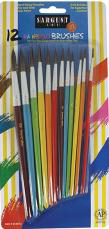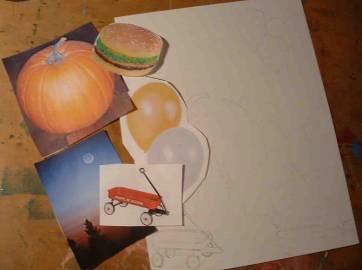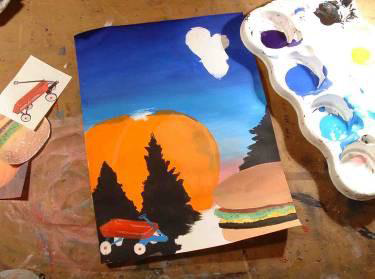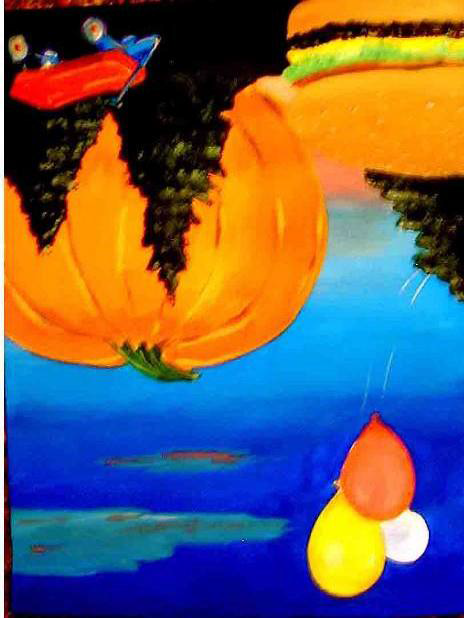Goal (Terminal Objective):
Students will create works of art demonstrating their understanding of dada and surrealism and their ability to integrate disparate images into a cohesive composition.
Objective:
Students will design and paint a surreal scene based upon a random selection of subject elements.
National Standards:
Visual Arts Grades 9-12 Content Standard 1: Understanding and applying media, techniques, and processes
Visual Arts Grades 9-12 Content Standard 3: Choosing and evaluating a range of subject matter, symbols, and ideas
Visual Arts Grades 9-12 Content Standard 4: Understanding the visual arts in relation to history and cultures
Visual Arts Grades 9-12 Content Standard 5: Reflecting upon and assessing the characteristics and merits of their work and the work of others
Visual Arts Grades 9-12 Content Standard 6: Making connections between visual arts and other disciplines
Purpose:
Students will explore aesthetic commonalities between poetry and art and will be able to create paintings that create surreal environments. Students will view and critically examine important works from the history of art.
New Vocabulary:
Aesthetic, Critique
Materials:
Paper or board, magazines

#56-6012 Natural Hair Rainbow Brush Assortment

#24-2499 Acrylic Paint

#22-7244 144 ct. Graphite Pencils
Time:
This lesson may be modified to last from one to three hours, depending upon size and complexity expectations.
Introduction and Motivation (Set):
Teacher asks students to select random words cut from newspapers and magazines and to create a verse or poem from the words selected. Students share their poems with the class. Teacher introduces the concept of Dada, the randomness in art inspired by the advent of World War I. Students will view exemplars of historical works of art in which the artist has used randomness as a theme. Some examples may be found in the works of Salvador Dalí, Luis Bunuel, and Man Ray. The class will then critique one or more of the examples, using the aesthetic scanning critique method. Critiques may be verbal or written, but must emphasize each student’s own personalinterpretation.
Instruction:
Teacher models the aesthetic scanning critique process.
Teacher organizes the classroom to facilitate students’ easy, orderly access to materials.
Teacher asks students to critique each of the exemplars using the aesthetic scanning method. Teacher may lead critique as a large group discussion, organize simultaneous small group critiques, or individual written critiques.
Activities:
(1) Guided Practice:
- Students critique images provided byteacher.
- Students select random images from magazines, catalogs,etc.
- Students make sketches for compositions that unify the random images in a cohesiveenvironment.
- Students use Sargent materials to complete the painting, carefully selecting and mixing colors to create faithful likenesses of the objects in a credible environment while maintaining a clear, balancedcomposition.
- Clean up with soap andwater.


(2) Independent Practice and Check forUnderstanding:Teacher circulates among the working students visually recording (checklist) students demonstrating understanding of objectives, asking direct questions when understanding isn’t observable, and asking peers to critique each other. Teacher helps and reinforces students as theywork.
(3) Closure:Finished, dry paintings may be displayed in theclassroom.
Evaluation:
: Use teacher or class critiques to evaluate particularly strong works and strong qualities within works.
Level One — The finished painting clearly creates a surreal environment. The rendering of objects and space is clear and convincing. The final piece also conveys a message, feeling, or theme. The student used materials appropriately and creatively. Composition is strong. Craftsmanship is excellent.
Level Two — The finished painting creates a surreal environment. The rendering of objects is clear. The student used materials appropriately. Composition is good.Craftsmanship is good.
Level Three — The finished painting displays randomness in the choice of images, but there is no understanding of surrealism apparent. The student used materials inconsistently. Composition is balanced. Craftsmanship is variable.
Level Four — The finished painting displays no understanding of surrealism. Materials are handled poorly. Composition is weak. Craftsmanship is poor.
Extension:
If time permits, students may work on larger paintings and may explore additional applications (eg.,installations, performances).
Resources:
www.salvadordalimuseum.org
www.manraytrust.com
Art Consultant



